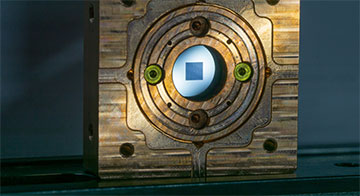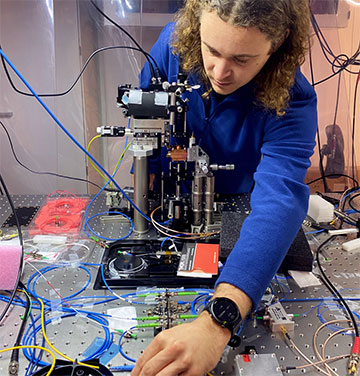
Embedding a mechanical resonator inside an optical cavity allows photonic information to be stored as mechanical vibrations and then converted back into an optical signal for onward transmission. [Image: Julian Robinson-Tait]
Researchers at the University of Copenhagen, Denmark, have shown that optical data at telecoms wavelengths can be stored in a mechanical memory device for as long as 23 ms (Phys. Rev. Lett, doi: 10.1103/PhysRevLett.132.100802). With just some minor modifications, their optomechanical system could also be used to store and retrieve quantum information encoded in the optical signals, which is an urgent requirement for extending the reach of quantum communication networks.
Membrane-in-the-middle
The mechanical device consists of a solid membrane patterned with a phononic crystal lattice that supports and confines long-lived resonant modes. Embedding the membrane inside an optical cavity provides the coupling needed for a coherent light beam to translate photonic information into sonic vibrations, while a second, much weaker laser is used to stabilize the optomechanical system.
Although similar schemes have been demonstrated before, in this new work the researchers sought to test the performance of their "membrane-in-the-middle" for storing and retransmitting photonic data. To write the optical signal into the mechanical memory―in this case a series of sinusoids with increasing amplitude―the sinusoidal waveform was superimposed onto the coherent beam. The control laser was then switched off while the signal was being stored, and then switched back on to retrieve the optical data.
Better preservation and efficiency

Study author Mads Bjerregaard Kristensen working in the lab. [Image: University of Copenhagen]
The experiments showed that the long-lived mechanical modes of the membrane can preserve the optical information for much longer than has been achieved with other optomechanical memories, which typically have been limited to the microsecond regime. The design also retrieves information with the highest efficiency yet recorded for an optomechanical system, at 40%, which is mainly limited by optical losses within the cavity caused by the presence of the membrane.
These initial tests were performed at room temperature using classical data signals, but the team is confident that the same approach could be adapted to store quantum data encoded in optical signals at moderate cryogenic temperatures of around 10 K. Such quantum memories will be crucial for sending quantum information over longer distances, in particular for creating specialized repeaters to boost the signal strength at regular intervals along an optical fiber, and for enabling data to be shared between distributed quantum computers.
